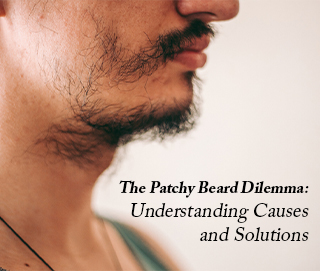The Patchy Beard Dilemma: Understanding Causes and Solutions

A lush, well-groomed beard is deemed a symbol of masculinity and style. However, for some individuals, achieving this look can be an uphill battle due to a host of reasons. Alopecia Barbae is considered one of the key reasons. This autoimmune disorder can lead to patchy bald spots in the beard, causing emotional distress and a significant impact on self-esteem.
In this blog, we will delve into the intricate details of Alopecia Barbae, the underlying causes of a patchy beard, and potential solutions, including the effectiveness of hair transplants.
What is Alopecia Barbae?
Alopecia Barbae is an autoimmune condition that specifically targets the hair follicles within the beard area, leading to the development of distinct bald patches. This condition, often referred to as “spot baldness,” is characterised by sudden and unpredictable hair loss in the beard region. It occurs when the immune system mistakenly identifies healthy hair follicles as threats and launches an attack against them. As a result, affected individuals experience patchy areas devoid of hair, disrupting the even patchy beard growth of their facial hair.
Although the exact cause of Alopecia Barbae remains elusive, genetic predisposition and environmental factors are believed to contribute to its onset. This condition not only poses physical challenges but also has emotional ramifications, impacting self-esteem and triggering body image consciousness. Understanding the underlying mechanisms of Alopecia Barbae is crucial in exploring effective patchy beard treatment options to help those affected regain their confidence and restore their beard’s natural appearance.
Real-life experiences of those affected by Alopecia Barbae underline the emotional turmoil caused by the condition. Individuals often share stories of frustration, embarrassment, and a loss of self-confidence due to the noticeable bald spots in their beards.
Understanding the Causes of Patch Beard
The frustration of a patchy beard, characterised by uneven hair growth and bald spots, is a common concern among individuals. This phenomenon is often linked to a condition known as Alopecia Barbae, or beard Alopecia, an autoimmune disorder. Delving into the underlying causes of this condition can shed light on the complex interplay of genetics, triggers, and immune responses that contribute to the development of patches in the beard.
Genetics and Family History
One of the primary factors contributing to a patchy beard is genetics. Family history plays a significant role in determining whether an individual is predisposed to autoimmune conditions like Alopecia Barbae. If close relatives have experienced autoimmune disorders or hair loss, the risk of developing similar issues increases. This genetic link underscores the complex hereditary nature of this condition.
Triggers and External Factors
While genetics lay the foundation, certain triggers and external factors can exacerbate the patchy beard dilemma. Stress, for instance, is known to have a significant impact on the immune system’s functioning. Intense or prolonged stress can potentially trigger or worsen autoimmune responses, leading to hair loss. Hormonal imbalances, such as those associated with thyroid disorders, can also contribute to the development of patches in the beard. Additionally, environmental factors like exposure to pollutants and toxins may play a role in disrupting normal hair growth patterns.
Link with Other Autoimmune Conditions
Alopecia Barbae is often not an isolated issue. It can be part of a broader spectrum of autoimmune disorders, collectively referred to as Alopecia Areata. This spectrum includes conditions affecting not only the beard area but also other body parts, such as the scalp. The link between these various autoimmune conditions suggests an underlying immune dysfunction that manifests in different ways throughout the body.
The causes of a patchy beard are multifaceted, involving a combination of genetic predisposition, triggers, and immune responses. Understanding these factors is crucial for those affected by Beard Alopecia Barbae, as it empowers them to make informed decisions about patchy beard treatment options and lifestyle changes. Recognising the intricate interplay between genetics and environmental influences can also pave the way for future research and developments in managing this challenging condition.
The Emotional Impact of a Patch Beard
The emotional toll of dealing with a patchy beard caused by Alopecia Barbae cannot be underestimated. Individuals often experience a significant blow to their self-esteem, leading to social anxiety and decreased self-confidence. Coping strategies and support systems are crucial for building self-confidence. Surrounding oneself with understanding friends and family, seeking professional psychological support, and joining support groups can aid in managing the emotional impact.
Acceptance of one’s unique appearance is a key aspect of dealing with the emotional impact of a patchy beard. Embracing one’s individuality and recognising that external appearance does not define one’s worth is vital.
Beard Transplant: An Effective Treatment Option
Beard transplants have emerged as a promising patchy beard solution for individuals dealing with Alopecia Barbae. The procedure involves taking hair follicles from a donor site (usually the back of the head) and transplanting them into the bald areas of the beard.
Beard transplants offer a transformative solution for individuals dealing with patchy or thinning facial hair, particularly those affected by conditions like Beard Alopecia.
These transplants provide several significant benefits. Firstly, they provide a natural and permanent patchy beard solution, as the transplanted hair is taken from the patient’s own body, usually the back of the head. This ensures seamless integration with existing beard hair, resulting in an authentic appearance.
Secondly, beard transplants have a positive impact on self-esteem and confidence. Restoring a full and well-groomed beard can significantly enhance an individual’s self-image, leading to improved social interactions and increased self-assurance.
Furthermore, the procedure itself is minimally invasive, often performed on an outpatient basis. This means minimal downtime and a relatively quick recovery. Additionally, the results of a beard transplant are long-lasting, reducing the need for ongoing maintenance and temporary solutions like topical treatments or wigs.
In essence, beard transplants offer not only a physical transformation but also a psychological boost, allowing individuals to regain their desired facial hair aesthetics and the confidence that comes with it.
Success stories of individuals who have undergone transplants for beard restoration underline the transformative effect of the procedure. These stories serve as a source of inspiration for those considering the patchy beard treatment.
Factors to Consider Before Opting for a Beard Transplant
Consulting a Specialist
Before opting for a beard transplant, it’s crucial to consult with a dermatologist or hair transplant specialist. Proper evaluation ensures that the procedure is suitable for the individual’s specific condition.
At DHI, we follow the UDSA diagnostic system, which includes four major components – DHI Alopecia test, psychological, dermatological and mathematical aspects. We leverage the insights derived from this cutting-edge and comprehensive diagnostic measure to offer our recommendations regarding a beard transplant or alternate patchy beard solutions.
Understanding the Procedure
A thorough understanding of the procedure, its expected outcomes, and potential risks is essential. This knowledge empowers individuals to make informed decisions.
At DHI, we strive to help you make informed decisions every step of the way. We leverage the best-in-industry and patented Direct Hair Implantation technique to ensure you receive the ultimate beard transplant experience. From hairline designing to ensure facial hair and beard symmetry to follicle extraction from the donor’s back of the head to follicle counting and implantation, the entire procedure at DHI is administered by reputed LHRTA-certified hair restoration specialists.
Addressing Cost and Maintenance
Considering the cost of the procedure and the long-term maintenance required for transplanted hair is important. While beard transplants offer a lasting patchy beard solution, they require ongoing care.
At DHI, we pride ourselves on the comprehensive before and after care and maintenance offered for all of our beard transplant services.
Other Treatment Options for Alopeica Barbae
Apart from beard transplants, various other treatments and medications are available for managing Alopecia Barbae. These include topical corticosteroids, immunotherapy, and minoxidil. These patchy beard treatments vary in their effectiveness, and individuals should work closely with healthcare professionals to find the most suitable option for their specific condition.
Complementary Approaches: Complementary approaches, such as adopting a healthy lifestyle, managing stress, and using specialised beard care products, can support overall beard health.
Nurturing a Healthy Beard
Beard Care and Grooming: Proper beard care and grooming are essential to maintain a healthy and attractive appearance. Regular washing, trimming, and the use of quality beard products can enhance beard health.
Recommended Products: Quality beard oils, balms, and shampoos can contribute to the health and vitality of beard hair. These products provide essential nutrients and hydration to the hair and underlying skin.
Skincare Routine: A consistent skincare routine that includes cleansing, moisturising, and exfoliating the skin beneath the beard can prevent issues that may contribute to hair loss.
In conclusion, the patchy beard dilemma caused by Alopecia Barbae is a challenge that can have a profound impact on an individual’s self-esteem and overall well-being. Understanding the causes of a patchy beard, the emotional toll it takes, and the available treatment options, including hair transplants, is essential for those seeking to restore their beard’s fullness and confidence.
By embracing both self-acceptance and the advancements in hair restoration techniques, individuals can overcome the challenges posed by Beard Alopecia and confidently embrace their unique appearance.
Choose DHI to regain your desired beard and facial outlook today!
